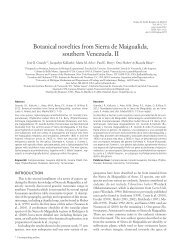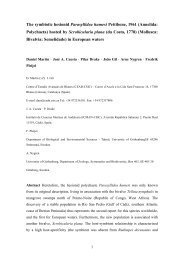FUNCTIONAL AND BIOACTIVE PROPERTIES OF COLLAGEN AND ...
FUNCTIONAL AND BIOACTIVE PROPERTIES OF COLLAGEN AND ...
FUNCTIONAL AND BIOACTIVE PROPERTIES OF COLLAGEN AND ...
Create successful ePaper yourself
Turn your PDF publications into a flip-book with our unique Google optimized e-Paper software.
hydrolysates and peptides have been produced from pig skin or bovine hide (Jia, Zhou, Lu, Chen, Li<br />
& Zheng, 2010). However, outbreaks of mad cow disease and the banning of collagen from pig skin<br />
and bone in some regions for religious reasons have made it necessary to find new marine or poultry<br />
sources, that are safer and healthier for consumers. Normally discarded collagenous materials from<br />
the poultry and fish processing industries, have been found to be valuable sources of hydrolysates and<br />
peptides with bioactive properties (Cheng, Liu, Wan, Lin & Sakata, 2008; Nam, You & Kim, 2008;<br />
Saiga et al., 2008; Cheng, Wan, Liu, Chen, Lin & Sakata, 2009). These collagenous materials may<br />
include skins, tunics, bones, fins and scales. Furthermore, the isolation of peptides with important<br />
biological activities has been reported for collagen and gelatin obtained from other sources like<br />
jellyfish, bullfrog or sea cucumber (Zhuang, Sun, Zhao, Hou & Li, 2010; Zhuang, Sun, Zhao, Wang,<br />
Hou & Li, 2009; Zhuang, Zhao & Li, 2009; Wang et al., 2010; Zeng, Xiao, Zhao, Liu, Li & Dong,<br />
2007; Zhao, Xue, Li, Tang, Wang & Wang, 2009; Qian, Jung & Kim, 2008).<br />
Gelatin and collagen-derived hydrolysates and peptides are generally obtained by enzymatic<br />
proteolysis. A number of commercial proteases have been used for the production of these<br />
hydrolysates and peptides, including trypsin, chymotrypsin, pepsin, alcalase, properase E, pronase,<br />
collagenase, bromelain and papain (Kim, Kim, Byun, Nam, Joo & Shahidi, 2001; Mendis, Rajapakse,<br />
Byun & Kim, 2005a; Lin & Li, 2006, Yang, Ho, Chu, Chow, 2008). Besides commercial proteases,<br />
enzymatic extracts from fish viscera have been used to obtain bioactive hydrolysates from skin and<br />
bones of different fish species (Phanturat, Benjakul, Visessanguan and Roytrakul, 2010; Jung, Park,<br />
Byun, Moon & Kim, 2005). Protease specificity affects size, amount, free amino acid composition<br />
and, peptides and their amino acid sequences, which in turn influences the biological activity of the<br />
hydrolysates (Chen, Muramoto & Yamauchi, 1995; Jeon, Byun & Kim, 1999; Wu, Chen & Shiau,<br />
2003). Alcalase, which is a commercial protease from a microbial source, has been used in numerous<br />
studies dealing with gelatin/collagen hydrolysis because of its broad specificity as well as the high<br />
degree of hydrolysis that can be achieved in a relatively short time under moderate conditions (Diniz<br />
& Martin, 1996; Benjakul & Morrisey, 1997). This enzyme manifested extensive proteolytic activity<br />
during the hydrolysis of skin gelatin from Alaska pollack, squid Todarodes pacificus and giant squid,<br />
producing hydrolysates with low average molecular weight which exhibited high antioxidant activity<br />
and ACE inhibitory capacity (Kim et al., 2001a; Nam et al., 2008; Giménez, Alemán, Montero, &<br />
Gómez-Guillén, 2009).<br />
The average molecular weight of protein hydrolysates is one of the most important factors which<br />
determines their biological properties (Jeon et al., 1999; Park, Jung, Nam, Shahidi & Kim, 2001).<br />
Peptide fractions from protein hydrolysates may vary in their effectiveness for a given biological<br />
activity. An ultrafiltration membrane system could be a useful and industrially advantageous method<br />
for obtaining peptide fractions with a desired molecular size and a higher bioactivity, depending on<br />
18

















